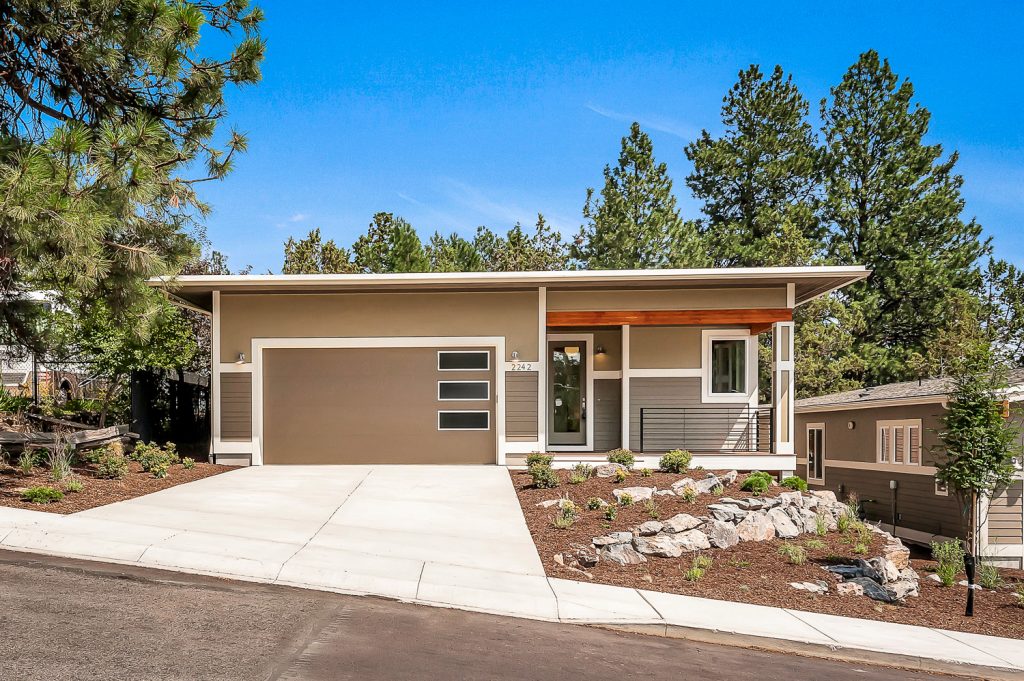Can flat roofs handle all that snow?
Yes!
If you live in Central Oregon, you know that winters can be harsh, with heavy snowfall and freezing temperatures. Flat roofs, a common architectural choice for their sleek and modern look, often raise questions about how well they can handle snow loads. This guide will break down what makes flat roofs effective, the engineering behind them, and why they’re a practical choice even in a snowy climate.
Why Flat Roofs Are Not Entirely Flat
Despite their name, flat roofs are not entirely flat. Most have a slight pitch, usually around 1/4 inch per foot. This subtle incline helps direct water and melting snow off the roof, which is crucial in preventing damage from pooling water and excess weight. Without this design element, roofs could face structural stress from accumulated moisture, especially after repeated snowstorms. The slight slope is key to ensuring water flows toward drainage points, reducing the likelihood of leaks and extending the lifespan of the roof.
How Flat Roofs Are Engineered for Snow Loads
Flat roofs are designed and engineered to withstand substantial snow loads. Builders follow strict building codes that ensure the roof can handle at least twice the maximum recorded snowfall in the area. In Central Oregon, the snow load rating for flat roofs is typically 25 pounds per square foot (psf), which provides a significant safety margin. Engineers also factor in wind load, the impact of snow drifting, and any potential ice accumulation when designing these roofs.
Flat roofs are often subject to stringent engineering reviews to confirm that they can safely carry the weight of heavy snow. These calculations consider not only the weight of snow but also the dynamic forces it creates. This means that flat roofs are often more resilient than expected, having been designed with the specific climate and potential snow load in mind.
The Role of Roofing Materials
Thermoplastic Polyolefin (TPO) is a popular roofing material for flat roofs in snowy regions. TPO is a single-ply roofing membrane known for its durability and resistance to weather conditions. It features high seam strength, which significantly reduces the risk of water infiltration, especially when snow sits on the roof for prolonged periods. Fewer seams mean fewer weak points, which is crucial when dealing with heavy snowfall.
Another benefit of TPO is its flexibility. During winter, temperatures can fluctuate dramatically between day and night. These fluctuations can cause roofing materials to expand and contract, creating vulnerabilities. TPO’s flexibility helps absorb these movements, maintaining a tight seal and preventing damage over time. TPO also reflects sunlight, which can help reduce heat buildup, making it an energy-efficient choice during the warmer months.
Drainage Systems and Snow Removal Techniques
Flat roofs rely heavily on effective drainage systems to prevent water accumulation. Drains, scuppers, and gutters are positioned strategically to ensure that melted snow is efficiently removed from the roof surface. Heated cables are also commonly used to facilitate snowmelt, reducing the chances of ice dams forming. Ice dams can be particularly damaging, as they prevent proper drainage and can lead to water seeping into the building.
Manual snow removal is another option, especially after particularly heavy snowfalls. However, removing snow must be done with care to avoid damaging the roofing membrane. Using a plastic snow shovel or hiring a professional service can prevent inadvertent damage. Snow removal should only be undertaken when the snow load exceeds the safe design threshold of the roof, as unnecessary shoveling could cause wear and tear.
Advantages and Disadvantages of Flat Roofs in Snowy Climates
Advantages:
- Modern Aesthetic: Flat roofs offer a clean, modern look that appeals to many homeowners. The minimalistic appearance adds value and character to contemporary homes.
- Usable Space: Flat roofs provide additional usable space, which can be utilized for placing solar panels, setting up a rooftop garden, or even adding an HVAC unit. This makes them a versatile option for homeowners looking to maximize their space.
- Cost-Effectiveness: Flat roofs are often less expensive to construct and maintain compared to pitched roofs. The reduced surface area requires fewer materials, and maintenance tends to be more straightforward.
Disadvantages:
- Snow Accumulation: Unlike pitched roofs, which naturally shed snow, flat roofs can accumulate significant amounts. If not properly managed, this can lead to increased stress on the structure.
- Maintenance Needs: Flat roofs require consistent maintenance to ensure that drains remain clear and the membrane remains intact. Regular inspections are necessary to address potential issues before they escalate.
Understanding Building Codes and Snow Load Requirements
In snowy regions like Central Oregon, building codes are stringent to ensure safety. The American Society of Civil Engineers (ASCE) sets guidelines that dictate how much snow load a roof must be able to bear. Local building departments may also impose additional requirements, such as periodic inspections following severe weather events, to ensure that roofs remain safe and structurally sound.
Working with an experienced structural engineer can help you navigate these regulations. They can provide insights into the specific snow load requirements for your area and make recommendations on how to improve the design of your flat roof to ensure maximum safety and durability.
Ensuring Long-Term Durability
Flat roofs are designed to be durable, but this durability depends heavily on regular maintenance. Materials like TPO are designed to last, but only if they are inspected and maintained properly. Homeowners should conduct regular inspections, especially after winter storms, to check for clogged drains, cracks, or any wear and tear on the roofing material.
Our new homes are built to withstand all sorts of weather:
Many flat roofs can last 20-30 years or more with proper care. Scheduling annual professional inspections can help detect early signs of damage, ensuring that small problems are addressed before they become costly repairs. Maintenance activities might include clearing leaves and debris from drainage systems, checking the integrity of the TPO membrane, and ensuring that any heating cables are functional.
If you live in Central Oregon, you know that winters can be harsh, with heavy snowfall and freezing temperatures. Flat roofs, a common architectural choice for their sleek and modern look, often raise questions about how well they can handle snow loads. This guide will break down what makes flat roofs effective, the engineering behind them, and why they’re a practical choice even in a snowy climate.
These flat-roofed homes, however, are designed and engineered with our local weather in mind. Go ahead and get a cool-looking, unique, mid-century modern home with a flat roof and enjoy your Central Oregon snowfall as well.
Central Oregon weather can be unpredictable, but homes, when properly engineered and built, are meant to handle the unpredictability.








